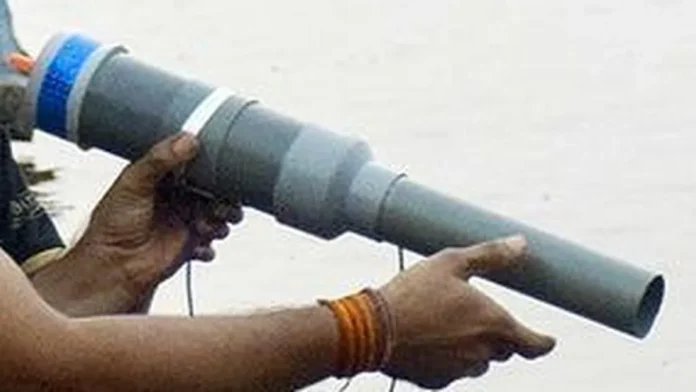This Diwali, a troubling trend turned festive joy into anguish for many families across Madhya Pradesh. Over 122 children were hospitalised with severe eye injuries within just three days of the festival, and at least 14 have reportedly lost their eyesight — all linked to the use of ‘carbide guns’, locally known as desi firecracker guns.
The makeshift guns mimic the sound of firecrackers and are made using explosive chemical components that can cause significant harm when used.
According to reports, doctors in multiple districts have described the injuries as among the worst they’ve seen during Diwali in recent years. Some children required emergency eye surgery, while others lost partial or complete vision in one eye.
What are ‘carbide guns’?
These handmade guns are often built from metal or PVC pipes and use calcium carbide — a chemical that reacts with water to produce acetylene gas, the same compound used in welding.
When ignited, the gas produces a loud explosion, mimicking the sound of firecrackers. Cheap, easily assembled, and available for as little as Rs 200, these guns are dangerously popular in smaller towns and villages.
But behind the thrill lies grave risk. The force generated by the gas explosion can send shrapnel flying, rupture eardrums, or cause permanent eye damage. In many cases, children experimenting with these makeshift guns are unaware of the chemical’s volatility or the risks of ignition in confined spaces.
Police said that the guns are being sold as “mini cannons” in local fairs and roadside stalls, with no safety regulations.
Why should this worry parents?
Doctors report that most victims were children between eight and 14 — old enough to explore and imitate what they see online, but too young to understand chemical risks.
One ophthalmologist in Bhopal said, “These are essentially mini bombs, not toys. A single mistake can cause irreversible damage.”
Parents often assume that a product being sold in the market must be safe — but in this case, there are no safety standards, no packaging, and no warnings. Some versions are even made at home using leftover pipes and small packets of carbide, making them unpredictable and extremely volatile.
What families can do: Simple safety steps
1. Keep an eye on what your child is bringing home.
If it’s a pipe-shaped object being used to make loud sounds or “mini blasts,” take it away immediately. These are not legitimate firecrackers.
2. Buy only licensed fireworks.
Always look for fireworks with BIS (Bureau of Indian Standards) marks, and buy from authorised vendors. Avoid anything sold without labels or instructions.
3. Talk before you celebrate.
Make a safety talk part of your Diwali preparations. Explain that loud doesn’t always mean fun and that some online “tricks” or challenges can be misleading.
4. Encourage safer celebrations.
Let kids light diyas, decorate homes, or make rangolis instead of focusing only on noise-based fun. Offer safer alternatives like sparklers or eco-friendly fireworks.
5. Have a plan in case of accidents.
If an eye or face injury occurs, cover the affected area gently with a clean cloth — don’t rub or rinse — and head straight to the nearest hospital. Quick medical attention can make a big difference.
/filters:format(webp)/english-betterindia/media/media_files/2025/10/15/sustainable-diwali-celebration-for-children-2025-10-15-13-17-35.png)
How to talk to your kids about it
Children often imitate what they see online or from peers, so it helps to approach the topic with calm and curiosity, not fear. Here’s how you can guide that conversation:
-
Start with curiosity: Ask what they’ve seen or heard about carbide guns or “firecracker guns.” Listen without scolding.
-
Explain simply:Tell them it’s a chemical device that makes a loud sound because of a dangerous gas reaction. You can compare it to a pressure cooker — “safe when used right, but harmful when misused.”
-
Show real examples: If possible, show them a short news clip or article explaining how children got injured — but frame it as “we can learn from this”, not “look how bad this is.”
-
Offer safe options: Suggest they take videos of lighting diyas, making decorations, or doing noise-free challenges — something creative instead of risky.
-
Empower, don’t frighten: Emphasise that being aware and making safe choices makes them responsible and smart — not boring.
What authorities and communities are doing
In response to the surge of injuries, several administrative and enforcement measures have been launched in Madhya Pradesh:
-
A ban on the manufacture, sale, and use of carbide guns in districts like Gwalior, along with seizure of devices and arrests under laws dealing with explosives.
-
Hospitals and district administrations have allocated special beds and emergency ophthalmology teams to treat blast‐related eye injuries.
-
Awareness drives are being called for: urging parents, schools and neighbourhood associations to treat these devices not as harmless toys but as miniature explosives needing cautious handling.
Sources:
‘What Are Carbide Guns? The Diwali ‘Toy’ That Left Over 300 Children With Eye Injuries: by Karishma Jain for News18; published on 24 October 2025
‘14 Kids Lose Eyesight In Madhya Pradesh Playing With ‘Carbide Gun’ On The so-called “carbide gun” or “desi firecracker gun,” by NDTV India, published on 23 October 2025
‘₹200 desi gun causes severe eye injuries: Social media trend reaches Bhopal markets, 23 people receive face and eye injuries’: by Shashank Awasthi for Bhaskar English, published on 20 October 2025
Feature image: Shutterstock
Disclaimer : This story is auto aggregated by a computer programme and has not been created or edited by DOWNTHENEWS. Publisher: thebetterindia.com









